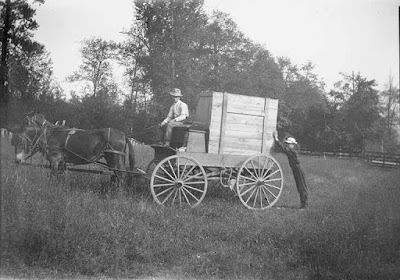Why
Mules?
Mules
are known to be ornery and uncooperative as compared to horses. So, why are
mules often preferred over horses by many for riding and for pulling a wagon?
Most
mules do not require grain, even when they are being worked.
Compared
to horses who will fill up on grain until they make themselves sick, mules
don't tend to overeat.
Mules
need less hay than horses -- and the hay doesn't need to be top quality.
Mules
will drink only what is necessary.
Mules
tend to be healthier than horses, a characteristic known as “hybrid vigor.”
Mules
tend to live longer than horses.
Mules
have a good sense of self-preservation. Unlike a horse, they will not go places
they decide it is unsafe. They are less likely to become injured because of
this.
Mules
tend to not overexert or overextend themselves the way a horse can. Men have
been known to run a horse to death. Mules tend to become “stubborn” and stop
before they allow that to happen.
Mules
usually have good, strong feet that don't require shoeing.
Because
of their feet are smaller and more upright, mules tend to be more sure-footed
than horses. Mules have been used extensively to transport cargo in rugged,
roadless regions such as large wilderness areas.
Mules
don’t tend to panic as easily as horses when they find themselves in difficult
situations.
The
debate rages between horse lovers and mule lovers as to which is more
intelligent. Based on the above characteristics, it does appear mules tend to
be endowed with a healthy dose of what can be called “common sense.”
Because
of these characteristics, many men in the old West preferred to ride mules over
horses. Although mules did not have the pulling capacity of oxen, they were
often used, particularly in rugged terrain, to pull wagons and even
stagecoaches.
With
its short thick head, long ears, thin limbs, small narrow hooves, and short mane,
the mule shares characteristics of a donkey. In height and body, shape of neck
and rump, uniformity of coat, and teeth, it appears horse-like. In spite of
their reputation for being stubborn, and ornery, many familiar with both horses
and mules will admit in difficult situations, a mule will tend to take better
care of its rider than a horse.
Let’s
give mules more respect.
In
the series, The Widows of Wildcat Ridge, the Wells Fargo stagecoach is pulled
by teams of mules. This is due to its setting high in the rugged Uinta
Mountains where the roads are not good and there are a lot of ups and down.
Likewise, in Diantha,
Book 14 in the series, I wrote scenes where Buck, the hero in my secondary
romance, arrives in Wildcat Ridge driving a wagon pulled by Mabel, the mare, and
Charley, the ornery mule. Charley doesn’t like most men, and will bite and kick
when they come too close to him. He likes Buck, and he particularly likes Buck’s
sweetheart, Hilaina Dowd.
Diantha is now on
preorder, but is scheduled to be released this coming Monday, April first. To find
the book description and purchase link, please CLICK HERE.
Join
me on the Widows of Wildcat Ridge Reader Group on Facebook between 9:00am and
4:00pm Pacific time to celebrate the release. To find that group, please CLICK HERE.
Sources:
https://animals.mom.me/advantages-mule-vs-horse-6118.html
Wikipedia
Wikimedia Commons










An informative post, Zina. My first introduction to mules in fiction was Jacquie Rogers' Much Ado About Marshals. She also wrote some shorts about a girl who owns mules. I've never ridden one, but I'd like to. Good luch with your release!
ReplyDeleteLoved the post! Cant wait for the new release!
ReplyDeleteI really thought I knew about mules... But I learned so much in this post... Thanks for sharing it with us!
ReplyDeleteThank you for a great post on what makes mules special. I have two donkeys and they are SO not like horses, even their blood work differs. Wishing you many sales for Diantha.
ReplyDeleteEnjoyed the interview and learned a lot about mules! Thank you for the information, i enjoyed it. :)
ReplyDelete